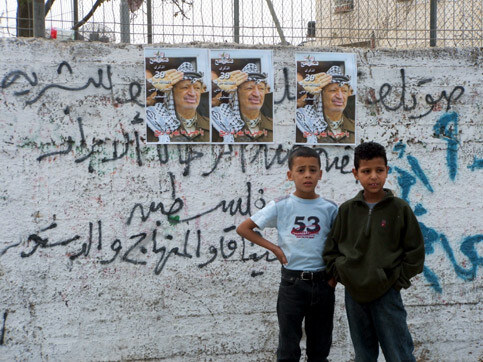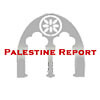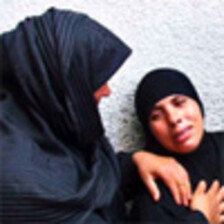Palestine Report 16 March 2005

The unstable, violent political situation and Israeli occupation undercut children’s development (Photo: Maureen Clare Murphy)
S. spent all of her childhood years and some of her adolescence with nine siblings: four brothers and five sisters. All of them lived in fear of their father, whose violence excluded none of them. Her father, rendered unemployed by Israeli closures on the Gaza Strip, only communicated with his children through physical and verbal abuse.
S. says not only did her father beat her constantly, but he encouraged her brothers to do so as well. She came to hate them all, she says.
S.’s story is one that is becoming increasingly common in Palestinian society. Statistics show that instances of domestic abuse have trebled in the years of the Intifada, and most experts agree that this is just the tip of the iceberg. In addition, the statistical correlation between the rise in abuse and the increasing oppression during the years of the Intifada leads most to conclude that while the occupation is not the only cause, it is the main cause and little can be done until it ends.
As she grew older, S. became obsessed with ways to rid herself of her tormentors. She describes her childhood home as an unbearable hell and as she entered adolescence, marriage was what she identified as the only way of escaping her reality.
Thus, she was overjoyed when the first suitor came knocking at her door. In him, she saw a savior and a ticket out of her father’s house. Although she didn’t love him or even know him, she immediately accepted his proposal.
S. was not quite 14 when she agreed to marry and admitted she knew little about the ways of the world. After her marriage to a boy not yet 17, the only change in her life became the change of abusive hands, from father to husband, who, as it turned out, would also hit and insult her for the most trivial of reasons.
S. bore the oppression in silence as her child-husband continued to abuse her rather than complain to her even more oppressive father. Her husband gained his strength from her weakness and grew more and more oppressive as time went on.
The abuse was not limited to her husband. S.’s mother-in-law also continually beat and insulted her, accusing her of “not being like other women.” S. was barren, unable, for reasons either physical or psychological, to bear children.
The abuse continued for two years during which S. could only hope things would get better. An even worse fate would be for her to divorce and return to her father’s house, she thought.
But things did not get better and S. finally reached a breaking point, demanding a divorce. Once it was finalized, she sought refuge in a program for the support and rehabilitation of women in the Gaza Community Mental Health Program (GCMHP). By the time she reached them, she was suicidal, suffered from respiratory problems, eating disorders and a chronic trembling of her arms and legs.
S. received psychological and moral support from the sessions in the program. She was on anti-depressants for over a year and a half until her condition improved. Through the program, she then enrolled in a course to become a beautician in order to be able to stand on her own two feet in the future.
Many victims of abuse like S. end up seeking refuge with social workers and specialists, and like her agree to speak only on condition of anonymity or through others, according to mental health specialist Shaher Yaghi of the GCMHP, and S.’s caseworker.
“Unfortunately, domestic violence has become a widespread phenomenon, especially toward children and women. It is seen as a means of venting anger and frustration as a result of various reasons whether that is unemployment, deprivation or the lack of satisfying certain needs,” says Yaghi.
Yaghi says the general oppression experienced by people as a result of the difficult circumstances under which they live must inevitably come out in some form. Many find that violence is the easiest way to vent their frustrations. Many of these people resort to violence against women because of their inability to effectively connect with their wives. That is, they lack a language of dialogue with others so they express themselves through violence rather than words.
Violence, Yaghi explains further, is not limited to corporeal abuse but also to verbal and psychological abuse, negligence and abandonment.
“Cases of domestic violence have almost tripled throughout the Intifada,” says Falak Khayat, director of the Family Defense Society. She says the cases of domestic violence have gone from 233 in 1999 to 641 in 2003 according to the Center’s statistics. Currently, the center is working on publishing new statistics for 2004. Broken down, says Khayat, incidents of psychological violence have risen by 223 percent while physical abuse rose by 157 percent in comparison to the years before the Intifada. Sexual abuse has risen by 38 percent.
This rise in the rates of domestic violence in Palestinian families, says Khayat, must basically be attributed to the years of escalating Israeli assaults and violence. The deteriorating economic and political conditions in the Palestinian territories coupled with the ongoing Israeli measures of assassinations, incursions, demolitions and other forms of violence have contributed to the overall feeling among fathers that they cannot fulfill their roles as protectors of the family. This feeling of inadequacy often generates violence in turn, mostly against women and children.
Khayat, however, maintains that this is not the only reason behind domestic violence. She says the traditions and culture of Palestinian society in particular and Middle Eastern societies in general are also factors that contribute to violence. In these, women are deemed as weak and deserving of pity but at the same time must be kept under the control and protection of men.
“Violence in the Palestinian territories, whether it is against women or children is becoming rampant and needs a serious and comprehensive study in order to minimize or even eliminate this phenomenon completely from society,” says Rula Shweiki, social worker for the Palestinian Family Planning and Protection Association (PFPPA).
Shweiki says the daily violence from the Israeli occupation in all its forms has a huge impact on the state of the Palestinian family. “The suppression and violence that people are subjected to daily at checkpoints, for example, will find its way out of the person being abused. Many times this is manifested in the person exercising violence against someone under his authority in turn. A vicious cycle is born.”
Shweiki also says that although many cases reach the Association, it is not nearly as many as those occurring in society. “The danger,” she says, “is a prevalent trend in society, especially among women and children, to escape from the violence by not talking about it in fear that it will be repeated. This is especially true for women who believe the abuse is part of the secrets of her household and that if she talks about it she will give her husband, father or brother an excuse to abuse her again.”
Others who dare tell usually do so anonymously and over the phone. What they basically want is to tell someone their problems. However, this is not very helpful in the more serious cases where the victim is extremely distressed. It also does not help stop the abuse.
Dr. Nader Saeed, director of the Development Studies Program at Birzeit University, says a survey conducted last September to October with 1,500 interviews in 75 locations in the West Bank and Gaza found shocking results. The interviewees were school students, housewives and teachers.
“The results were incredible,” says Saeed. Physical abuse in West Bank districts reached 42 percent and 33 percent in the Gaza Strip.
Because women are considered the weaker sex in Palestinian and Arab society, explains Yaghi, she is expected to endure abuse without responding or informing family or the police. Many times she does not even protest for fear of the consequences. “Violence of this sort has many negative affects on women including a sense of low self-esteem, feelings of unworthiness, depression and despondency over the future,” Yaghi says.
Still, violence against women does not compare to the abuse of children, who are subjected to all forms of abuse either from parents, teachers or older peers, she adds.
Around 50 percent of students have been verbally abused inside their classrooms during the year 2003-2004, while 19 percent have been subjected to verbal insults with sexual implication by teachers or guards. About eight percent of students have been sexually harassed on school grounds, either verbally or by inappropriate touching, says Saeed, quoting his program’s survey.
Saeed says much of the abuse that children are subject to can also be attributed to the Israeli occupation. He says the occupation is the general framework for violence, whether at school or at home. The survey showed that 44 percent of all students have to cross Israeli checkpoints and 20 percent are subjected to curses and insults by soldiers. Eighteen percent have seen their schoolmates killed.
Saeed says violence against school children causes a myriad of nervous problems including learning and reading disabilities and stuttering. The frustration this creates can in turn lead children to vent their anger toward weaker students.
One schoolteacher who refused to give her name, says although teachers know they will be penalized by education ministry officials should they use corporeal punishment against students still sometimes resort to it “when they have to” against certain students. The teacher says some instructors are forced to use physical punishment against students who come from a violent background.
Other teachers agree that instructors in general are not aggressive by nature nor do they prefer to use corporeal punishment. When they are forced to physically punish a student, it is justified as a way of enforcing their authority in the classroom and as a warning to other students.
Saeed says the issue of abuse is the responsibility of the entire society including the government, NGOs and civil society institutions not to mention political factions, which utilize violence internally or as part of the resistance. But he stressed that ending this phenomenon must start in schools.
Shweiki believes the only thing that will get society out of this crisis is by incorporating a culture of non-violence. She agrees with Saeed that this must start with the schoolteacher. The difficulty, however, for any teacher, is that before being an educator this person is a Palestinian, and thus subjected to the violence of the occupation as well as outmoded traditions.

Related links:




